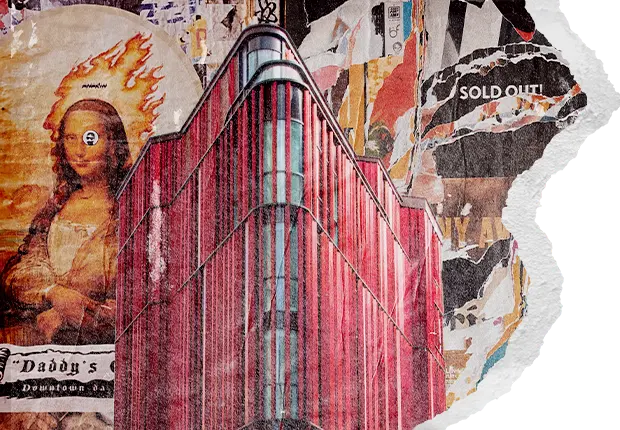From Renaissance to Ruin
The first site Adolf Hitler wanted to see on his tour of Paris in June of 1940 was the neo-baroque building of the Opera Garnier. In order to fit in with the military brass, the artists and architects in the entourage were given field-gray uniforms. Present among them, Albert Speer later recalled in his memoir: “All the lights glowed as they would on a gala night. Hitler had undertaken to lead the party. Having studied the plans of the building with great care beforehand, he went into ecstasies about its beauty, his eyes glittering with an excitement that struck me as uncanny.”
Oh, Paris. When it reigned supreme as a model of urban delights, cities around the world vied for comparison with it. When Russian Tsar Peter the Great completed his European-inspired reconstruction project and moved the capital west, St. Petersburg became the “Paris of the North.” Taking advantage of the economic prosperity and political autonomy within the Austro-Hungarian Empire in the late 1800s, the Hungarians embarked on a nation-building enterprise, quickly securing Budapest the epithet of “Paris of the East.”
Early in the 20th century, another city started attracting the coveted comparison. At the time when Buenos Aires became the “Paris of South America,” Argentina’s GDP per capita was higher than that of France. The country’s prosperity was luring British capital investments hand over fist and immigrants from Italy and Spain by the millions.
Alas, a century later, today, one finds Argentinians flocking back across the ocean to work Madrid’s restaurant tables, happy to have escaped the hyperinflation and the pessimism of their ailing nation, where 40 percent of the population lives below the poverty line.
When Tucker Carlson went to Buenos Aires in September of 2023 to interview presidential candidate and libertarian economist Javier Milei, one of the first questions he asked was about the city’s “sublimely beautiful and stupendously ugly” architecture. Milei pointed out that the city’s architectural jewels, such as the famed opera house Teatro Colón built in 1908, reflect the period of the country’s successful liberalism, whereas the recent Soviet-style “squat and ugly” concrete structures are manifestations of the “leftist values” of “envy, hatred and violence.” Socialism “always and everywhere” creates incentives for poverty.
Milei made it clear that allowing a nation to be captured by socialist ideology leads to a castration of wealth creators, a descent into poverty, an architectural spiral into brutalism, a plunge into crime, and – crucially – a frustration of the aspiration in the mind. Violence is a common thread throughout.
We can easily observe what violence has wrought on the streets of formerly grand cities. I vividly recollect a night walk in Havana – “Paris of the Caribbean” – through the courtyard of a formerly grand mansion with high ceilings incongruously carved out into small apartments. An imposing white marble staircase, much battered by footsteps and the elements, emanated muted grandeur in a setting of peeling walls, leaking roofs, broken overhead lamps, laden clotheslines, and a mural of Che Guevara signed “Socialismo o Muerte.” Socialism and death seems more appropriate.
How quickly can violence – revolutionary, criminal or otherwise – cripple a city? Detroit is our Exhibit A. Once upon a time, the heart of the American automotive industry and “Motor City,” “Motown” and “Rock City,” “Hockeytown” — and yes, “Paris of the Midwest.” And then, somehow, without warning, Detroit turned into “Murder City” and “Bankrupt City.”
Detroit’s decline is a painful self-feeding saga of crime, racial violence, corruption, “white flight” and economic breakdown. Emblematic of the situation were the riots of the “Long Hot Summer of 1967,” resulting in 43 deaths, 7,000 arrests and 2,500 burned buildings. The city never recovered. Today, its remaining stupendously beautiful Art Deco buildings glumly echo the forgotten metropolis that once boasted America’s wealthiest postal code and a nearly successful bid for the 1968 Olympics.
Sadly, subsequent money-is-no-object, decades-long attempts at revitalizing Detroit have come to naught. It looks as though, once a city destroys itself, it is condemned to perdition forever – as if the gods are deaf to the supplications of those who squandered the inheritance of their forefathers. Ask a native of Cairo. Ask a Londoner.
“Hardly any British people still live in the city,” chant some of those who left London for happier parts of the country. “It is no longer the place it used to be.” At the risk of breaking royal decorum, Prince Charles often and loudly bemoaned the painful lacerations of modern architecture on his beloved London. He coined memorable visual metaphors for the perpetrators’ handiwork.
The towers surrounding London’s St. Paul’s Cathedral are a “basketball team standing shoulder to shoulder between you and the Mona Lisa.” The National Theater looks like a “nuclear power station” and the British Library like “a place for burning books.” And, most famously, the extension plans for the National Gallery on Trafalgar Square are “a monstrous carbuncle on the face of a much-loved and elegant friend.”
As odd as it may seem, the prince, now King Charles III, is on the side of the people. Poll after poll shows that people across the political spectrum prefer, by margins as high as three to one, traditional building designs. So why did planners and architects the world over abandon traditional architecture in favor of that modernist cocktail du jour of steel, glass and concrete? These people argued and still argue that there can be no escape from the hard imperatives of functionalism and utilitarianism, minimalism and cost-efficiency, rapid construction techniques and adaptable design.
Reports of the demise of traditional architecture have been greatly exaggerated. The obituary has yet to be posted in the “Paris of the East” – that’s Budapest, remember. After the collapse of the Soviet regime, Hungary, like most of Eastern Europe, found itself poking with a stick through the ashes of its past, looking for embers of self-identity to rekindle. In 2010 a new wave of political leaders moved focus and investment to restore Budapest’s architecture to its Belle Epoque glory – before WWII planes dropped bombs on its bridges and communism dropped brutalism on its buildings.
The scale of the effort included the entire Buda Castle district, city squares, churches, government structures, the reconstruction of monuments and the renovation of the famed State Opera. The project has garnered serious internet fame, with Twitter full of before and after pictures of restored buildings, not so subtly declaring that “it can be done,” that the fire of the nation’s soul can still be found among the rubble of national humiliation and communist brainwashing.
On the other side of the world, similar refrains of national restoration are often sung at meetings of the Beijing Politburo faithful. For example, in his speech in 2021, celebrating the Communist Party’s “100 years of glorious struggle,” President Xi Jinping evoked the word “rejuvenation” 31 times. The humiliating defeat in the Opium Wars of 1839 and the subsequent “fight” against “imperialist” and “hegemonic” enemies are front and center in the minds of party leaders and their propaganda.
Tasked with the architectural rejuvenation of the face and the body of the nation, fired up by a “can-do anything” attitude, Chinese urban planners embraced modern designs as well as Western historical classicisms, ranging from “classical dressing” of plain buildings to large-scale replication of European towns. Tianducheng is “Fake Paris” with its own Champs-Élysées and Eiffel Tower. Elsewhere in the land, there are “Thames Town” with a replica of Christ Church from Clifton in England and “Little Florence” with the canals and bridges of Venice.
Despite criticism of vulgar mimicry, these are the places thought to confer class and high social standing in Chinese society. The country’s richest corporations agree. Huawei’s R&D campus in Dongguan is like its own planet inhabited by 25,000 employees. Twice the size of Apple Park in Cupertino, California, and built as 12 distinct European towns connected by a network of Swiss-style red trams, its 108 European-themed buildings produce an overwhelming cacophony of aesthetics. Here is Versailles Palace and there is Budapest’s Liberty Bridge. There are green parks with bike paths as well as tranquil lakes with black swans. There are no glass towers with parking lots.
What unites the Chinese and the Hungarians is the memory of a struggle against a brutal outsider keen to destroy the heart and soul of their nations. “Rejuvenation” carries energy when “we” restore what “the enemy” destroyed – be it with Luftwaffe planes, communist repression or the opium trade. Londoners beautifully rebuilt London after 1945, the Hungarians patiently fixed up Budapest once they got freedom, the Chinese speedily revived the nation out of its “dark period” when it became economically feasible.
Detroit, on the other hand, destroyed itself. There is no energy for rejuvenation in the divided community passively observing the face of its city being burned off. There is no aspiration in the heart when the enemy is one’s self. Prince Charles put it well when he said:
“The London that slowly evolved after the Great Fire took about 300 years to build. It took about 15 years to destroy. You have to give this much to the Luftwaffe. When it knocked down our buildings, it didn’t replace them with anything more offensive than rubble. We did that.”
The light of aspiration seems to warm the hearts of the Chinese and the Hungarians, as it does the bosoms of the Eastern Europeans and the Baltic people. It may burn inside Javier Milei who yearns to save Argentina from socialism. It seems to lead President Nayib Bukele of El Salvador to fight crime in his nation.
The most important rule to embrace on the path to rejuvenation, we can conclude, should be to guard against any threat to economic prosperity like our very lives depend on it. The power of the Roman Empire is what fueled the construction of the Colosseum and the Aqueduct of Segovia. Beautiful offspring emerged when the Italian Renaissance bedded the Medici Bank. The magic of petrodollars is what turned desert sand into the sparkling megacities of Dubai and Doha.
Peace is prosperity, peace is prosperity. As the joke about the Swiss goes, they are not smarter than the Danes, they just enjoyed 700 years of peace.
Fight crime to the death. It can be done, ask a Salvadoran. Do not go soft on small, infectious misdeeds like graffiti. A great past is not enough to mobilize rejuvenation. Take note of Cairo, “Paris on the Nile,” or Detroit.
If under oppression, guard the light of the nation’s soul for as long as it takes until there is a historical schism and an opening for those with long memories to blow away the ashes covering the smoldering remains. Ask a Hungarian, pray for a Ukrainian.
Those who come after us will strive to preserve the structures that we built with a view of the future – those that were forged to withstand the test of time, Lindy and antifragile.
And alas, finally, there’s this sorry truism to consider as well: elect your politicians wisely.
When the Vienna Academy of Fine Arts rejected Hitler’s admission applications in 1907 and again in 1908, it struck him “like a bolt from the skies,” he wrote in Mein Kampf. We all know what happened next, hence all the memes about sensitive art-school rejects. The man who stood in awe in front of the Paris Opera and proclaimed that “architecture has the power to change the world” ended up bombing Europe into rubble. There appears to be a design feature in the nature of the human heart that pulls us both to create and to destroy, to plant a flower and to want to stomp it out, to build breathtaking beauty and to erect carbuncles.
Since I began with Paris in the Second World War, and with the words of Albert Speer, I’ll end with them too. Hitler is telling Speer of his thoughts about that great city, and of greater things to come.
“’Wasn’t Paris beautiful? But Berlin must be made far more beautiful. In the past I often considered whether we would not have to destroy Paris,’ [Hitler] continued with great calm, as if he were talking about the most natural thing in the world. ‘But when we are finished in Berlin, Paris will only be a shadow. So why should we destroy it?’ With that, I was dismissed.”
The thought brings to mind the words of Jordan Peterson, that in order to integrate his shadow self, man “must be an absolute monster and learn to control it.” The shape of the face of our world depends on it.
































